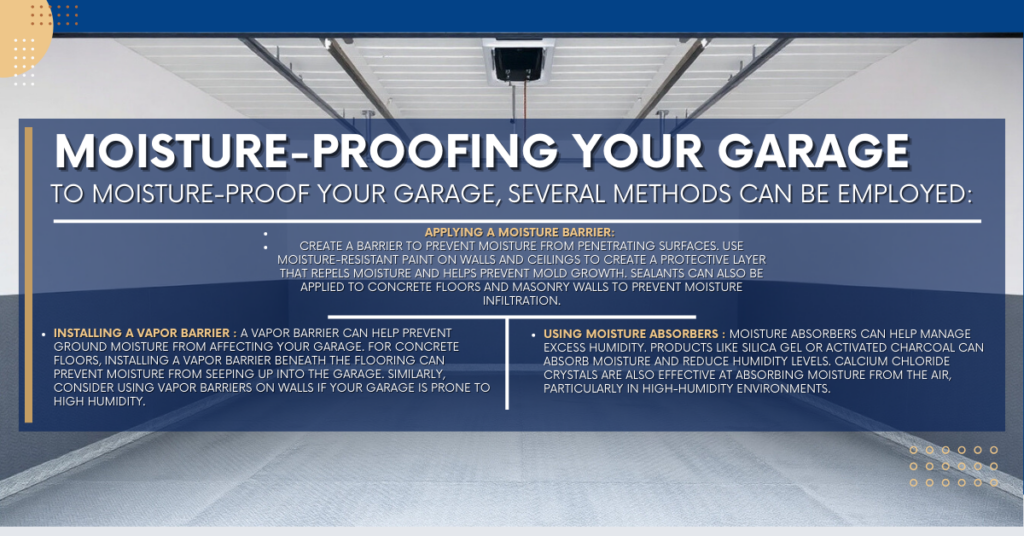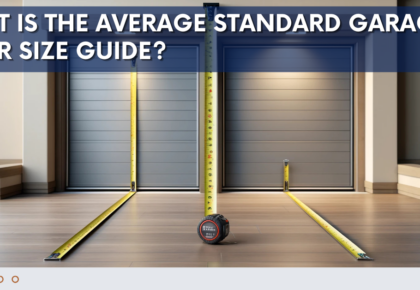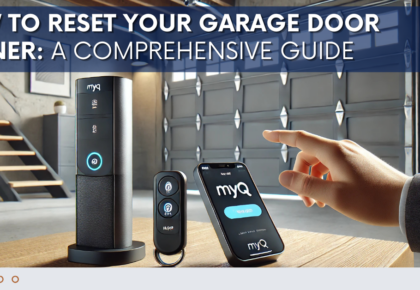Managing humidity in your garage is crucial for maintaining its structural integrity and ensuring a comfortable environment. Excess moisture can lead to numerous issues, including rust, mold growth, and unpleasant odors, which can negatively affect both the garage itself and the items stored within it. Here’s a detailed guide on how to effectively manage and control humidity levels in your garage.
Causes of High Humidity in a Garage
High humidity in a garage can stem from several underlying causes. One common issue is poor ventilation. When a garage lacks proper airflow, moist air can become trapped, leading to increased humidity and condensation. This stagnant air is a breeding ground for humidity problems. Temperature fluctuations are another contributing factor, especially in uninsulated garages. When warm, moist air encounters cooler surfaces, it can condense, raising humidity levels. Additionally, water leaks from sources such as pipes, roofs, or walls can introduce moisture into the garage. These leaks can persistently increase humidity if not promptly addressed. Finally, ground moisture can seep into the garage, particularly if the floor is not adequately sealed or if the garage is below ground level.
Ideal Humidity Levels in a Garage
Maintaining the right humidity level is essential for preventing moisture-related problems. Ideally, garage humidity should be kept between 30% and 50%. This range helps to inhibit mold growth, prevent rust, and ensure a comfortable environment. When humidity levels exceed this range, it can create conditions favorable for mold spores and corrosion, which can lead to damage to both the garage structure and stored items. Regular monitoring with a hygrometer can help you keep track of humidity levels and make necessary adjustments.
Effective Strategies for Reducing Garage Humidity
To effectively reduce humidity in your garage, consider the following strategies:
Improving Ventilation
Proper ventilation is one of the most effective ways to manage humidity. Start by installing vents in walls or the roof to facilitate air exchange. Passive vents can help in areas where active ventilation might not be feasible, allowing moist air to escape and fresh air to enter. Exhaust fans are another option; they actively expel moist air from the garage, reducing humidity levels. If weather conditions permit, open garage doors and windows to allow fresh air to circulate. This natural ventilation can be particularly effective on dry, breezy days.
Insulating Your Garage
Proper insulation helps to regulate temperature and reduce condensation. Insulate walls, ceilings, and even the garage door if necessary. By maintaining a more consistent temperature, insulation reduces the likelihood of condensation forming on cold surfaces. Insulating the garage door can also help in maintaining internal temperature stability and minimizing moisture buildup.
Sealing Gaps and Leaks
To prevent outside moisture from entering your garage, sealing gaps and leaks is crucial. Begin by inspecting your garage for any leaks in pipes, roofs, or walls. Repairing these leaks promptly can prevent water ingress and associated humidity issues. Additionally, use weatherstripping or caulking to seal gaps around windows and doors, which helps to keep moist air out and maintain a stable internal environment.
Using Dehumidifiers
A dehumidifier can be an effective tool for controlling garage humidity. It works by drawing in moist air, removing the moisture, and then expelling drier air. This process can significantly lower humidity levels and is particularly useful if your garage is prone to high humidity or if you store sensitive items. When choosing a dehumidifier, look for a model suited for garage use that can handle varying temperatures and conditions. Place the dehumidifier in a central location for optimal effectiveness, and remember to regularly empty the water reservoir and clean the filters to ensure efficient operation.
Moisture-Proofing Your Garage

To moisture-proof your garage, several methods can be employed:
Applying a Moisture Barrier
Create a barrier to prevent moisture from penetrating surfaces. Use moisture-resistant paint on walls and ceilings to create a protective layer that repels moisture and helps prevent mold growth. Sealants can also be applied to concrete floors and masonry walls to prevent moisture infiltration.
Installing a Vapor Barrier
A vapor barrier can help prevent ground moisture from affecting your garage. For concrete floors, installing a vapor barrier beneath the flooring can prevent moisture from seeping up into the garage. Similarly, consider using vapor barriers on walls if your garage is prone to high humidity.
Using Moisture Absorbers
Moisture absorbers can help manage excess humidity. Products like silica gel or activated charcoal can absorb moisture and reduce humidity levels. Calcium chloride crystals are also effective at absorbing moisture from the air, particularly in high-humidity environments.
Alternatives to Dehumidifiers
If you prefer not to use a dehumidifier, there are alternative methods to manage garage humidity:
Using Fans
Fans can improve air circulation and help reduce humidity. Ceiling fans can promote air movement and reduce stagnant air, while portable fans can be used in specific areas prone to dampness. Positioning fans near sources of moisture or in areas with poor airflow can enhance their effectiveness.
Utilizing Natural Ventilation
Natural ventilation can lower humidity levels by allowing moist air to escape and fresh air to enter. Open opposite windows and doors to create a cross-breeze, which helps to reduce humidity. Additional ventilation openings can also be installed to improve airflow and further decrease humidity.
Baking Soda and Charcoal
Household items like baking soda and activated charcoal can absorb moisture and help manage humidity. Place bowls of baking soda or activated charcoal in humid areas to absorb excess moisture and neutralize odors.
Cooling a Humid Garage
Cooling a humid garage can also help reduce humidity levels:
Using an Air Conditioner
An air conditioner can cool and dehumidify the garage simultaneously. Consider using a window air conditioner or a portable unit designed for garages. Air conditioners help manage both temperature and humidity, making them a versatile solution for hot and humid conditions.
Installing Ventilation Fans
Ventilation fans can help expel hot, humid air from the garage. Exhaust fans are particularly useful for removing both heat and moisture, while attic fans can help expel hot air from the upper space if your garage has an attic. Reflective window films can also reduce heat gain from sunlight, further helping to keep the garage cooler.
Fan vs. Dehumidifier
Both fans and dehumidifiers serve different purposes. Fans improve air circulation, which can aid in moisture reduction, but they may not be sufficient for high humidity levels. A dehumidifier directly removes moisture from the air, providing more effective humidity control. Using a dehumidifier in conjunction with fans can offer optimal results, combining improved air circulation with targeted moisture removal.
Addressing High Humidity
To address high humidity, start by identifying the sources of moisture and addressing them directly. Implementing strategies such as improving ventilation, using dehumidifiers, and ensuring proper sealing and insulation can help reduce and manage humidity levels. Regular maintenance and monitoring are key to maintaining optimal humidity and ensuring a dry and comfortable garage environment.
By following these guidelines, you can effectively manage and control humidity levels in your garage. Whether you choose high-tech solutions or natural methods, keeping moisture in check will protect your garage and its contents, ensuring a dry, comfortable, and functional space.








